| EXPLANATION
OF THE TABLEAUX.
THE
blank spaces show where the foundation cards should be played during
the deal. When they are taken from the pack to form part of the
original tableau the proper cards are painted.
EXPLANATION
OF TERMS.
Available
cards. Those that are not
"blocked" by other cards, i. e. not forbidden by the
particular rules of each game, to be used. Released cards. Those
which, by the removal of the cards that blocked them, have now become
available.
Suitable
cards. Those whose value
and suit fit them to be played or placed in the tableaux.
Foundation
cards. Those on which the
Patience is formed, These are generally aces and kings.
Marriage.
The placing a card of the same suit on the next one above or below it
in value. Any number may be placed on each other in this way.
Sequence.
The regular succession
of
cards ascending from ace to king, or descending from king to ace; a
sequence need not be of one suit.
Value.
The figures of the court cards, and the number of points of the minor
ones.
Suit.
Either hearts, spades, diamonds, or clubs.
Lane.
An empty space in the tableau, which has been formed by the removal
of an entire row of cards.
Talon.
Cards which, being unsuitable at the moment, are laid aside in one or
more packets till they can come into use.
To
play cards. The placing
them on the foundations in contradistinction to placing them
elsewhere.
Re-deal.
These are always in addition to the original deal.
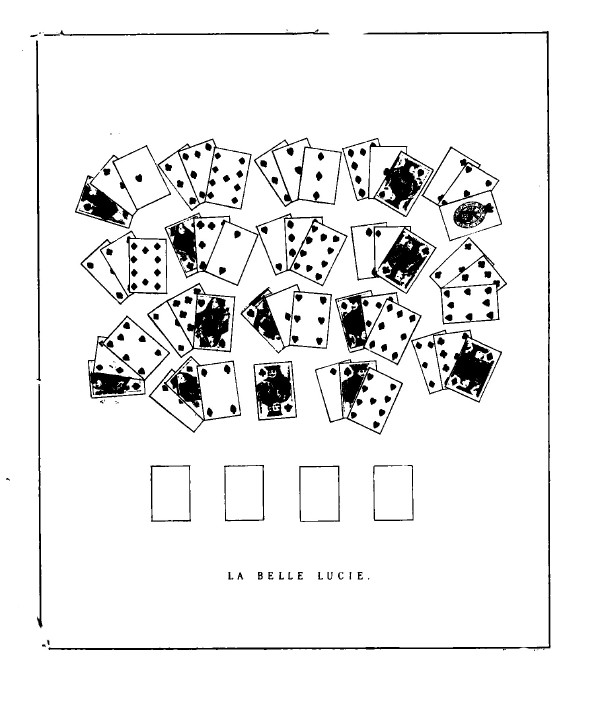
LA
BELLE LUCIE.
ONE
ENTIRE PACK OF CARDS.
RULES.
I.
THE uppermost card of each packet is alone available, until by its
removal it releases the one beneath.
II.
The foundations must follow suit.
PLAY.
Deal
out the entire pack in packets of three cards dealt together and
placed as in tableau. The last packet, however, will contain but one
card.
The
four aces form the foundation cards, and are to ascend in sequence to
kings.
Having
placed the tableau, take any aces that may appear on the surface of
the packets and play them in their allotted spaces, and upon them any
other suitable cards, subject to Rule I.
When
all available cards have been played, you proceed to release others,
by forming marriages in a descending line on the tableau; but great
care is requisite, lest in releasing one card another still more
necessary to success should be blocked. The whole tableau should be
carefully examined, and the combinations arranged so as to release
the greatest number of suitable cards.
When
this has been done, and that there are no more available cards to
play, the entire tableau may be taken up, shuffled and re-dealt (if
necessary twice), then played again as before.
This
game can also be played with two packs, the eight aces forming the
foundation cards, and double the number of packets being dealt for
the tableau. It is then called "THE HOUSE IN THE WOOD."
There
is also another way of playing it with two packs. The foundation
cards to be four aces, and four kings of different suits, and
marriages made both in ascending and descending lines. The name of
this game is "THE HOUSE ON THE HILL."
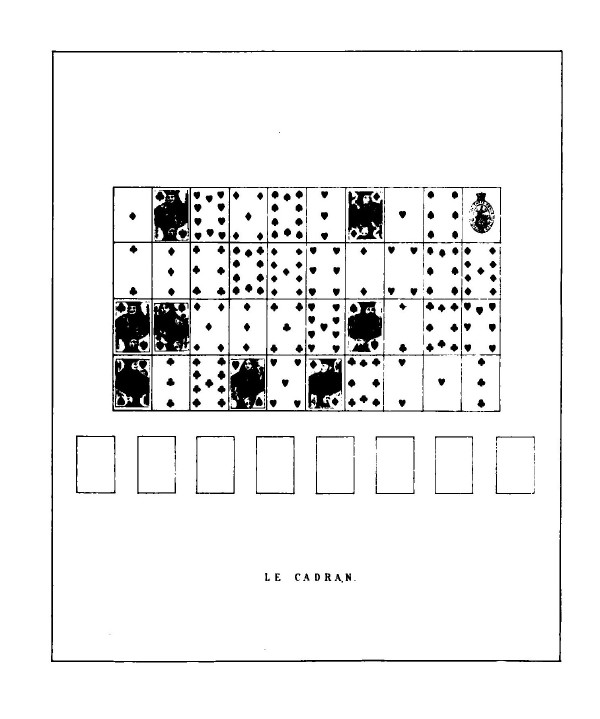
LE
CADRAN.
TWO
ENTIRE PACKS OF CARDS.
RULES.
I.
ONLY cards in the lowest row are available, until a card in any other
row is released by the removal of those below it, the principle being
that no card can be used that has another below it.
II.
The foundations must follow suit.
PLAY.
Deal
out from left to right four rows of ten cards.
The
eight aces, when they can be placed, form the foundation cards, and
are to ascend in sequence to kings.
Should
any aces appear in the lowest row, play them in their allotted
spaces, and upon them any suitable cards to continue the foundations
(Rule I.)
You
must now examine the tableau and endeavour by forming marriages (in
descending line, and always subject to Rule I.) to release other
suitable cards. This, however, must be done with care, lest a
sequence in a lower row may block a card above it which is much
wanted, and might soon have been released.
If
by these changes you can make a vacancy in the uppermost row (thus
forming a perpendicular lane), it is of the greatest use. The vacancy
may be re-filled with any available card from the tableau or from the
talon, but you are not obliged to re-fill it until a favourable
opportunity occurs.
Note.
— Some players only allow the vacancy to be filled from the talon.
The card so placed has all the privileges of the original card whose
place it fills, and is treated in the same manner. When there are no
more available cards to play, proceed to deal out the remainder of
the pack, turning the cards one by one, playing all suitable ones on
the foundations, or placing them on the sequences of the tableau. The
cards that cannot be so employed are laid aside in one packet forming
the talon.
There
is no re-deal.
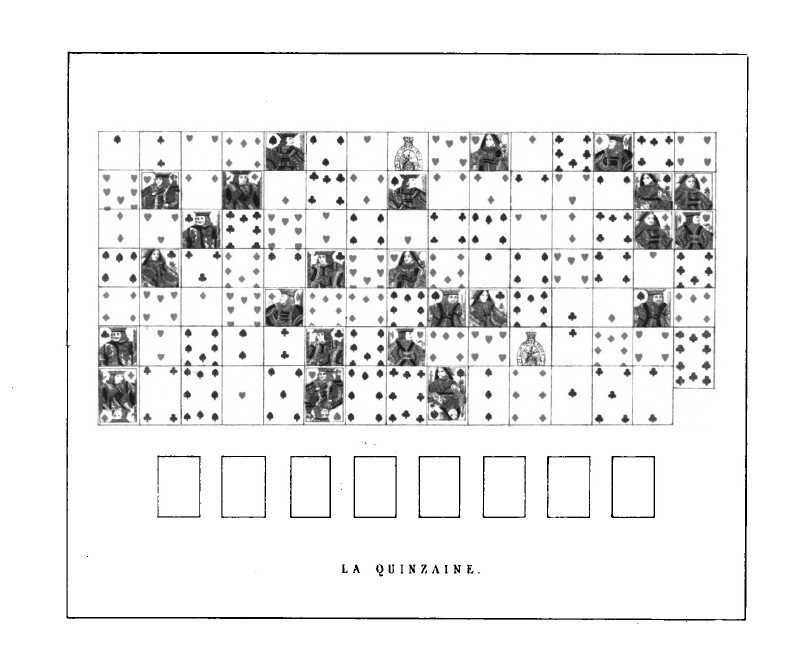
LA
QUINZAINE.
TWO
ENTIRE PACKS OF CARDS.
RULES.
I.
ONLY cards in the seventh or lowest row are available, until by their
removal those above them are released. No card can at any time be
used that has any other below it.
Note. — There is one exception to this rule,
in case the game cannot be
opened. See below.
II.
Each foundation must follow suit.
PLAY.
Deal
out the entire pack from left to right, in horizontal rows, fifteen
cards in each, excepting the last one, which can only contain
fourteen. Each row should partly cover over the preceding one; four
aces and four kings form the foundation cards, the aces ascending in
sequence to kings, the kings descending in sequence to aces. When the
deal is complete, if any foundation cards should appear in the lowest
row (Rule I.) play them at once on the spaces reserved, and also any
other suitable cards — then marry, both in ascending and in
descending lines, subject to Rule I.; but if, after these changes, no
foundation card is available, so that the patience cannot even begin,
you may withdraw from the sixth row one ace and one king, if any are
to be found (see note to Rule I.) immediately filling the spaces so
made with the cards below which had previously blocked them. If even
this resource is unavailing, the patience has already failed, there
being no re-deal, and no further infringement of rules allowed.
When
one or more foundations are established, examine the tableau
carefully, marry all available cards, and endeavour by these changes
to release the greatest number of suitable cards for the foundations,
and to open out one or more perpendicular lanes. These are of the
greatest use; you may select any available card and place it at the
top of the lane, and below it any others in sequence of the same
suit, each card partly concealing the preceding one, as in the
original deal.
You
may also use the lane for reversing any sequences previously made.
Thus, supposing there is a sequence beginning with a ten and ending
with a three (the ten being required for one of the foundations),
place the three at the top of the lane, the other cards following
until the ten becomes the lowest or available card.
In
theory this patience is simple, but it is very difficult to play. The
combinations are endless, from the constant reversing of sequences,
and require great attention. As the success principally depends on
the lanes, it is more prudent, when you have only one, not to re-fill
it until by some fresh combination you can open out another one.
There
is no re-deal.
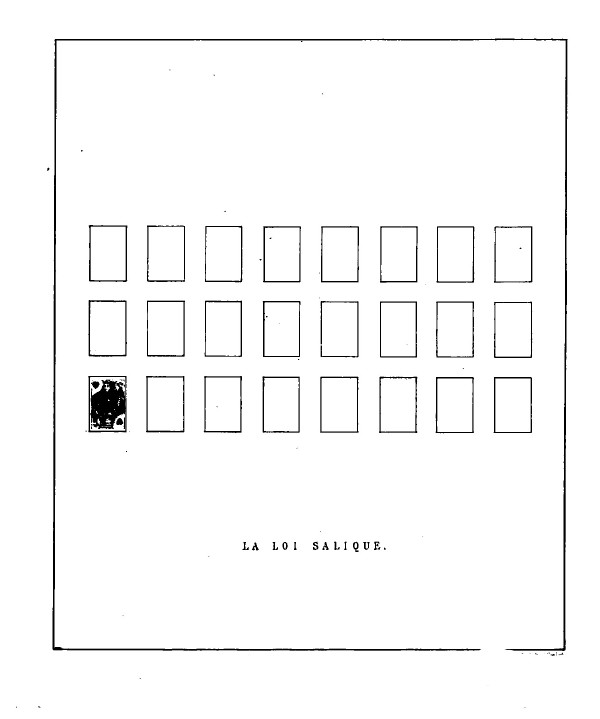
LA
LOI SALIQUE.
TWO
ENTIRE PACKS OF CARDS.
RULES.
I.
ONLY the cards on the surface of the king packets are available,
until their removal as usual releases those beneath, but all the
cards in each packet may be examined.
II.
The foundations do not follow suit.
PLAY.
Take
from the pack and place one-king to begin the line of eight kings,
that are to be successively placed in a horizontal row as they appear
in the deal. On this first king you place all the cards as you deal
them until the next king appears. You now place the cards as you deal
them upon this second king, and you continue thus to deal out the
whole pack, always heaping upon the last king that has appeared all
the cards as they are dealt.
The
eight aces are to form the foundation cards, and are to ascend in
sequence to knaves (Rule II.) When in the course of the deal any aces
appear, they are to be immediately placed in a line above the king
packets, and upon them any suitable cards (Rule I.), and when the
queens appear they are to be placed in a row above the foundations.
The queens are merely placed to complete the final tableau, which if
the patience succeeds, consists of the eight queens above, the eight
knaves finishing the foundations in the centre, and the eight kings
below. You must continually examine the surface of the king packets
to play any suitable cards on the foundations, and in so doing
endeavour to free some of the kings entirely, for when the deal is
ended you are allowed to place one card from any of the other packets
(Rule I.) on each king, and you must of course choose those cards
that will release the greatest number of suitable cards for the
foundations, for which purpose the whole packets may be examined. In
this consists the entire play.
There
is no re-deal.
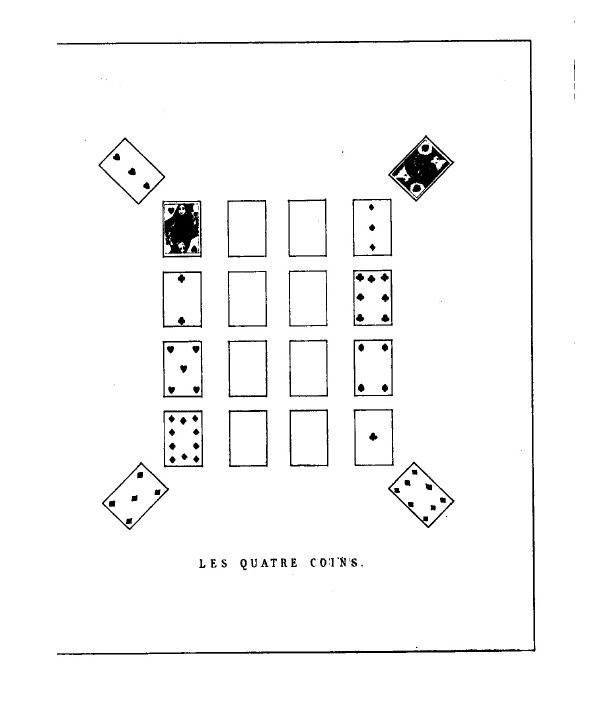
LES
QUATRE COINS.
TWO
ENTIRE PACKS OF CARDS.
RULES.
I.
AFTER the deal is completed, the uppermost card of each packet is
available and may be placed on any of the foundations, the cards
underneath being released as usual by the removal of those that
covered them.
II.
Each foundation must follow suit.
PLAY.
Deal
out twelve cards as in tableau, beginning on the left. Place the top
corner card, then the four side cards, lastly the lower corner card;
repeat this process on the right hand, beginning with the top corner,
and leaving space in the centre for the foundation cards. These will
consist of four aces and four kings of different suits, the aces
ascending in sequence to kings, and the kings descending in sequence
to aces.
Having
dealt the first round of twelve cards, proceed to deal out the entire
pack in successive rounds covering the first one, but in dealing each
several round the following method must be strictly observed.
The
eight foundation cards as they appear in the deal (whether they fall
on the corner or on the side packets) are to be at once played in the
space reserved for them, and on these may be played any suitable
cards which in dealing fall on either of the four corner packets; but
when a card (otherwise suitable) falls on either of the side packets
it may not be played unless the foundation to which it belongs
happens to be the one immediately adjoining the side packet on which
that card fell in dealing.
Note.
— Whenever in dealing a card is withdrawn, to place on one of the
foundations, the next card in the pack is placed in its stead.
After
the entire deal is completed these restrictions cease, all suitable
cards may now be played, subject to Rule I., and marriages, both in
ascending and descending lines, may be made with cards on the surface
of the twelve packets; great care must, however, be taken in making
these marriages, lest in releasing one card you block another that is
equally required. The contents of each packet should be carefully
examined, and only those marriages made which release the greatest
number of suitable cards.
Note.
— The sequences thus made may be reversed if required, viz.
if one of the packets contained a sequence, beginning with deuce and
ascending to eight (this being of course the top card) and one of the
other packets had at the top a nine of the same suit, the eight might
be placed on the nine, the rest of the sequence following, till the
deuce became the top (or available card).
When
all possible combinations have been made, and further progress
is impossible, the twelve packets may be taken up in order, beginning
on the left, re-dealt, and played exactly as before. If necessary,
there may be two re-deals.
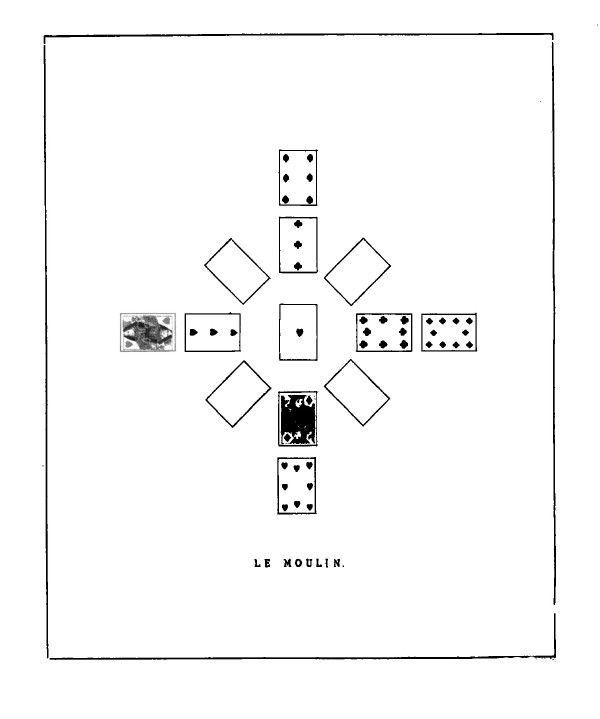
LE
MOULIN.
TWO
ENTIRE PACKS OF CARDS.
RULES.
I.
ALL cards in the wings are available.
II.
The five foundations do not follow suit.
PLAY.
Take
from the pack one ace and place it in the centre before you; next
deal out eight cards, grouping them round the ace to represent the
wings of a windmill. The first four kings that appear in dealing are
to be played in the four angles (see tableau). These, with the centre
ace, form the five foundation cards. Each of the four kings is to
descend in sequence to ace, while upon the centre ace four entire
families are to be piled in sequences (Rule II.).
Having
placed the centre ace and the wings, take from the latter any kings
for the foundations, or other suitable cards to play on them, or on
the centre ace, filling up the spaces so made from the cards in your
hand. Then proceed to deal out the remaining cards, turning them one
by one, playing all whose value admit of it on the foundations. The
cards that cannot be so used are placed aside in one packet forming
the talon.
Note.
— The four families on the centre ace each begin with ace and end
with king.
It
is better to play cards from the talon rather than from the wings.
Vacancies
in the wings must be immediately re-filled from the pack or talon.
In
forming the foundations, the uppermost card of either of the king
packets may be transferred, if suitable, to the ace packet; but this
privilege is limited to one card of each at a time, and may only be
resorted to when the playing of that card would bring into immediate
use any other available card of the wings or of the talon.
There
is no re-deal.
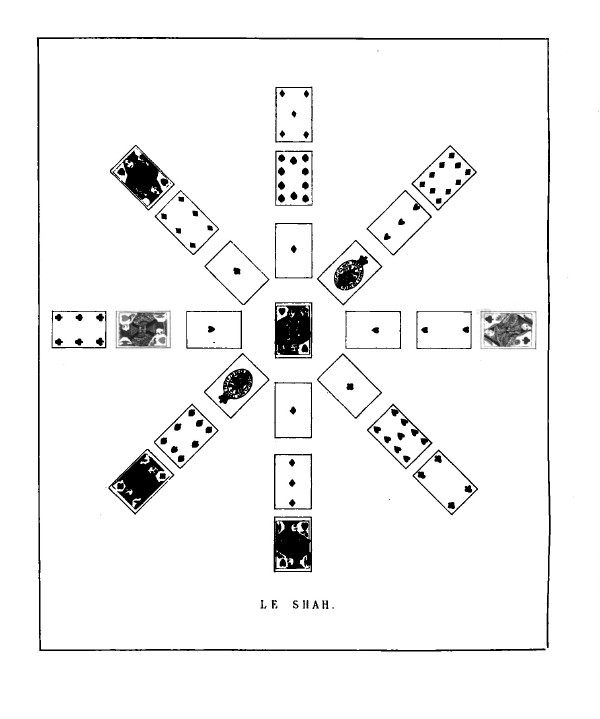
LE
SHAH.
TWO
ENTIRE PACKS OF CARDS.
RULES.
I.
DURING the deal cards in each circle of the star are available until
another circle blocks them. After the deal is completed only cards in
the third (or outer) circle are available until, as usual, their
removal releases the inner circles.
II.
Marriages are limited to cards in the third circle; cards in the
inner circles, even when released, can only be played, but not
married.
III.
The foundations must follow suit.
PLAY.
Take
from the pack the eight aces and the eight kings. Throw aside seven
of the kings and place the remaining one in the centre, with the
eight aces surrounding it in a circle.
The
king is called The Shah, and remains alone. The aces are the
foundation cards, and are to ascend in sequence to queens.
Next
deal out a circle of eight cards, beginning at the top and continuing
from left to right. If any of these are suitable, play them, filling
the spaces at once from the cards in your hand. Then deal out a
second circle, blocking the first one (Rule I.), and treat it in the
same manner, then a third circle, which completes the rays of the
star.
Note — In the pattern tableau the third
circle is omitted for want of
space.
You
should now examine the star to see if there are any available cards
which it would be advantageous to marry, or to play (Rules I. and
II.), but you are not obliged to do either until a favourable
opportunity occurs. Marriages can only be made in descending line.
Note.
— It is often better to wait until, in dealing, a card turns up
likely to be soon required, and then by playing or marrying, you make
a vacant space in which to place it.
When
you have played or married all the cards you wish, the spaces so made
must be re-filled from the talon or pack, beginning with the inner
circles, and proceeding from left to right as before.
The
remaining cards are dealt out in the usual way, those not required
for the foundations, or for marrying, or for re-filling spaces,
forming the talon.
When
a lane, i. e.
one entire ray of the star, is opened out, the place of the inner
card may be filled by one card from the third circle. This is
sometimes of great use, and is a kind of "grace," as this
patience seldom succeeds. The other two spaces are re-filled from the
talon, and this must be done at once, as each ray must always be
complete.
There
is no re-deal.
|

